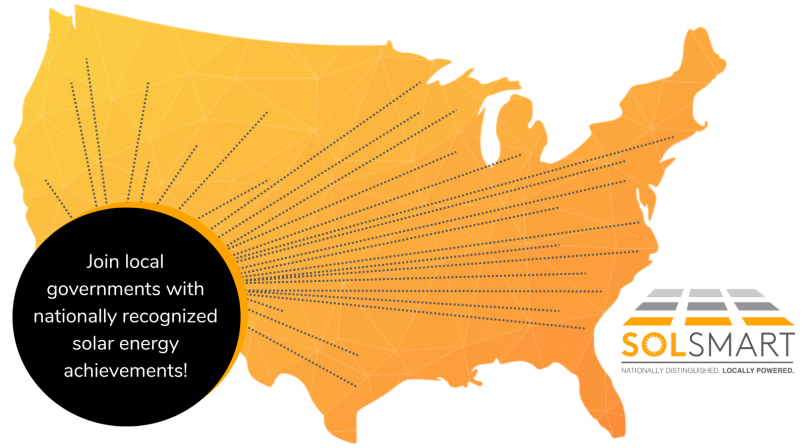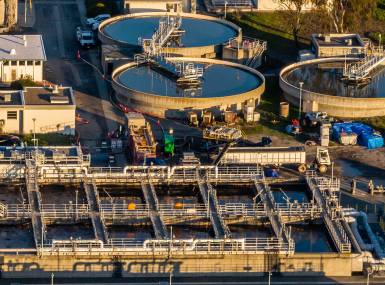More than 400 communities are now solar energy-ready
Upcoming Events
Related News

Key Takeaways
The SolSmart program has reached an exciting new milestone: Over 400 counties, municipalities and regional organizations have achieved SolSmart designation! SolSmart communities can be found in 41 states, the District of Columbia and the U.S. Virgin Islands, representing a total of over 100 million people. These SolSmart-designated local governments have expanded local solar knowledge, reduced ‘soft costs’ and other obstacles to solar energy and increased solar technology use in their communities.
Counties are in a unique position to help reduce the ‘red tape’ of solar onboarding through the county permitting and inspections process. As local solar markets grow, counties are also positioned to help shape where and how solar is developed in their community through local planning and zoning. NACo has been a proud partner to The Solar Foundation, ICMA and other solar energy and local government partners on the U.S. Department of Energy-funded SolSmart program since its launch in 2016. By improving the local solar onboarding process and becoming more solar-ready through SolSmart, counties can tap into the rapidly growing solar industry and reduce the costs for residents and businesses to invest in solar energy technology.
New Research Shows Impact on Solar Market
The SolSmart program is also pleased to share the results of a new third-party evaluation. This research shows that SolSmart provides significant benefits to participating communities and has measurable impacts on the solar market.
The research found that SolSmart designees added between 300-450 Megawatt (MW) of solar capacity and 12,800-19,200 new installations nationwide. This translates the $10 million in taxpayer funds for SolSmart into $1-2 billion in additional solar investment. The study also found that SolSmart speeds up the permit process for solar installations by 7.5 days on average. In addition, local governments and industry officials say one of the largest impacts of the SolSmart program has been increased local knowledge about solar energy. Learn more about this research and report here.
Counties Shine
To date, 90 county governments have reached SolSmart designation. Below is a snapshot of solar-ready, SolSmart-designated counties in action. To learn more about SolSmart-designated counties, reference this new fact sheet, solsmart.org, or NACo’s SolSmart report, Thinking SolSmart.
San Miguel County, Colorado (Gold) San Miguel County completed a site analysis on using solar energy at county buildings using expertise and resources from SolSmart. The county is now on target for on-site, grid-tied solar photovoltaic (PV) to supply half of the electricity at its facilities by the end of 2021. Battery storage will also provide resiliency for 911 dispatch and an emergency operations center. To make access to solar energy even easier and more affordable for all, the county also collaborated with the San Miguel Power Association and other local and state partners to launch an innovative community solar project on a former county landfill site.
Charleston County, South Carolina (Gold) Charleston County is establishing itself as a leader on sustainability and resilience in South Carolina and the region. The county worked with SolSmart to develop a straightforward permitting and inspection process, making it easier for businesses and residents alike to go solar. The county is now pursuing solar energy projects on two downtown buildings connected to the College of Charleston. Recently, Charleston County worked with state partners to establish CORE-SC, a consortium that develops research and solutions on the resilience challenges facing South Carolina.
Montgomery County, Maryland (Gold) Montgomery County has set the aggressive goal of 100 percent greenhouse gas reductions by 2035, and solar deployment will be key to reaching that goal. The county has incorporated more than 7 megawatts (MW) of solar at government buildings, including microgrid projects at the public services headquarters and a correctional facility. Plans are in the works for major solar projects on a decommissioned landfill and a next-generation bus depot. The county has a Solarize campaign underway that incorporates both solar and electric vehicle (EV) charging, and its green bank programs offer financing options for residents, businesses, and nonprofits.
Pulaski County, Virginia (Gold) Pulaski County worked with SolSmart to streamline permitting and zoning processes to make it easier for residences and business to go solar. This year, the county approved a 300 MW utility scale solar project that would be one of the largest in the Eastern U.S. The project is expected to bring new revenue to the county and to the participating private landowners, while supporting existing industry and attracting new industries that value renewable energy. The county worked diligently to address community concerns with the project including impacts on viewshed.
How SolSmart Can Help Your County
Is your county interested in learning more about local solar energy processes? Has your county already acted locally to plan for and spark solar energy development? All counties in the nation, as well as municipalities and regional organizations, are eligible to participate in the SolSmart program. The program offers both 1) no-cost guidance and technical assistance to help your community become more solar-ready and 2) national recognition for solar-leading counties that have taken local solar action to be SolSmart-designated.
To learn more about the program and how to be involved, please read this new SolSmart fact sheet, visit solsmart.org, or reach out to Jack Morgan, NACo Program Manager, Resilient Economies & Communities.
Featured Initiative
SolSmart
SolSmart is a national program that helps cities, towns, counties and regional organizations become solar energy ready.

Related News

Congress examines PFAS liability and cleanup regulations
On December 18, the U.S. House Energy and Commerce Subcommittee on Environment held a hearing examining the current statutory and regulatory landscape for PFAS. The hearing follows a similar hearing held by the U.S. Senate Environment and Public Works Committee on November 19.
‘Fix-It Fair’ brings new life to damaged items, helps divert waste
Thurston County, Wash. partnered with a non-profit to help residents fix things that are difficult to recycle.

U.S. House of Representatives passes SPEED Act and other permitting reform bills
On December 18, the U.S. House of Representatives passed the SPEED Act (H.R. 4776). The SPEED Act would strengthen county involvement in decision-making and make needed commonsense reforms to the federal environmental review process.